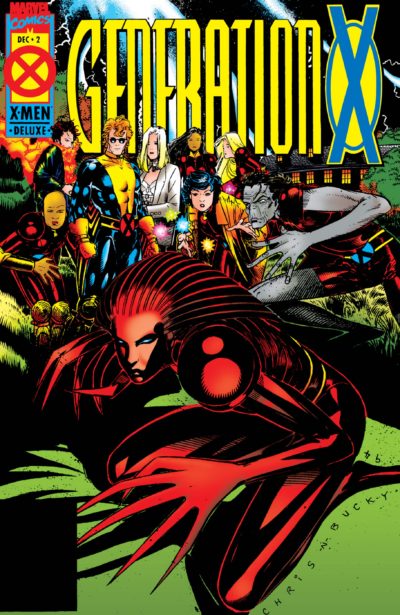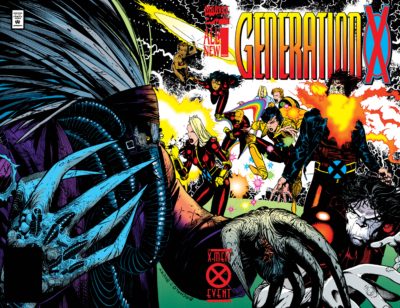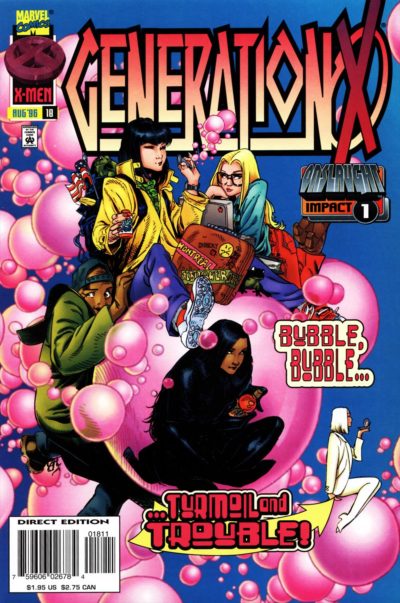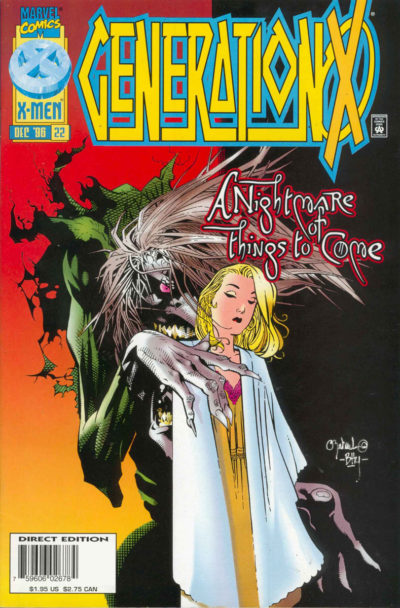Generation X arrived on the verge of the X-Men franchise’s glory days starting to spoil in the Onslaught era. For that reason, many fans tend to write it off – or, they weren’t even around for it.
Yet, the comic readers who stuck by the X-Men through the 90s know that Generation X wasn’t more of the same compared to other X-Men books of the period. A huge part of that was the Scott Lobdell and Chris Bachalo creative partnership that lasted through the first few years of the series.
 Generation X, Vol. 1 AKA by Lobell & Bachalo is the #36 Most-Wanted Marvel Omnibus of 2017 on Tigereyes’s Secret Ballot.
Generation X, Vol. 1 AKA by Lobell & Bachalo is the #36 Most-Wanted Marvel Omnibus of 2017 on Tigereyes’s Secret Ballot.
Visit the Marvel Masterworks Message Board to view the original posting of results by Tigereyes, and head to my Guide to Young X-Men to see how many issues of this series have already been reprinted in collected editions.
Past Ranking: #26 in 2016
Probable Contents: This volume would certainly include Generation X #1-25 & Annual 1995, 1996, 1997, and material from Generation X Ashcan Edition, San Diego Preview, and material Generation X Collector’s Preview. It wouldn’t be surprising to also see Uncanny X-Men #316-318 and X-Men #36-37 duplicated from the Phalanx Covenant OHC.
That makes for a somewhat short volume that slightly cuts off the end of the Lobdell/Bachalo run, but it marries to the Operation Zero Tolerance OHC, which begins at #26. Alternately, this book could duplicate #26-31 from that volume to include the complete works of the original creative team, also adding #-1 – pencilled by Bachalo.
(It could also add Daydreamers #1-3, which continues from Generation X #25 and has never been collected.)
Either way, the remainder of the series could likely be knocked out in a single additional volume starting from #32.
Creators: This run is primarily written by Scott Lobdell and drawn by Chris Bachalo with Mark Buckingham and Scott Hana on inks.
An army of pencillers fill in for the year where Bachalo is away – notably including Roger Cruz and Tom Grummett. Issues #28-31, if they were to be included, were written by James Dale Robinson.
Can you read it right now? No. There’s are a pair of Generation X classic trades that run from #1-11, but then you’re stuck with floppies until #26. Guide to Young X-Men covers that and all the rest of the series.
It’s the same story on Marvel Unlimited – #1-11, then straight to #26.

The Details:
Generation X was the totally weird X-Men book that no one knew they wanted but everyone was strangely happy to have when it launched in 1994.
It used to be that New Mutants was the book with the young, school-age cast and Excalibur was the oddball book full of humor. That had changed in the prior year, with X-Force focusing more on a proactive approach to preserving the mutant race and Excalibur finally being sucked into all of the standard X-Men crossover drama.
That left a hole to be filled by a quirky book set at a school. That is what Marvel launched out of the Phalanx Covenant crossover, which introduced a new generation of mutant coveted by the race of techno-organic life forms.
Generation X wasn’t just quirky. It was something altogether different and more transgressive than any X-Men title that had come before. It was a book full of superheroes who wore uniforms but hardly acted as a team. If they had any unifying theme, it was that their powers were metaphors for adolescence that doubled as body horror.
Some characters were never comfortable in their own skin. Husk’s power was to rip off her own flesh to reveal something different, while Skin just had way too much of it. Others had powers focused on keeping people at a distance, like the mysterious and mute Penance with her razor sharp flesh and Chamber, who had a hole filled with psychic fire where his face ought to be. Another, Sync, couldn’t help but imitate everyone else.
In this crowd, the previously hip Jubilee seemed positively antiquated!

That says nothing for their signature villain, Emplate: a creepy-looking elephant man out of phase with reality who devours… something… from other mutants to sate his thirst and who was connected to seemingly perfect pretty girl Monet, who would occasionally fall into an occasional catatonic state.
Oh, and their co-headmaster (along with Banshee) was Emma Frost, then mostly known as White Queen – a longtime villain whose last student body was slaughtered wholesale by sentinels.
And that’s just what we find out in the first few issues!
Scott Lobdell takes some flack in hindsight for occasional wheel-spinning during his tenure over multiple X-Men books, but this one was a strange little gem. That’s in large part due to stunning artwork from co-creator Chris Bachalo, who does a bare majority of these issues.
There’s no doubt that Bachalo’s style of horror crossed with steampunk influenced the plot development of the book. He was a rare mid-90s Marvel artist with a very serious critical pedigree at a point in time when the biggest, flashiest artists were largely defecting to other publishers from Marvel. He was straight off of a run on Shade: The Changing Man for Vertigo with Peter Milligan and before that he drew the legendary Death: The High Cost of Living with Neil Gaiman.
This was the first time an indie comics aesthetic had been brought to bear on an X-Men title. Many of the issues in this run have that feeling of stuff that simply happened to people. Not Claremontian soap opera stuff, but random events and coincidences that make up a quirkier version of life as we know it. The book was lackadaisical even while being overtaken by events like The Age of Apocalypse (where Bachalo turns in a quartet of stunner issues – they’re so good it’s almost worth collecting them here despite their lack of relevance to the ongoing plot).
Bachalo makes an initial departure with #6, returning a year later with #17 to stay through the end of this run (though he contributes covers while he’s away). Without him, the book drifts. A focus on Banshee followed by an overlong Omega Red encounter starts to feel like more of the same standard-issue X-Men before we get back to more weirdness with Emplate.
Without him, the book drifts. A focus on Banshee followed by an overlong Omega Red encounter starts to feel like more of the same standard-issue X-Men before we get back to more weirdness with Emplate.
Lobdell and Bachalo both had the opportunity to turn in a swan song for their initial plots in #25, a muddled issue that hardly even starred the team in favor of a Greek chorus of minor characters lead by Howard the Duck.
Yet, even as Generation X got sucked into Operation Zero Tolerance in the following issues, it never became a run-of-the-mill X-Men book of mutants dealing with some variable in the outside world. They have enemies, but they mostly have each other.
Will we see this omnibus in 2018? Probably not, but this wouldn’t be a terrible time for Marvel to kickstart an Epic Collection line for this title, which could easily cover it in just four books.
That’s because Marvel has revived the Generation X title for the first time since the original volume was cancelled just this month for a new series penned by Christina Straight.
Would I recommend buying it? Not to your standard Marvel fan, no. Even a big fan of 90s X-Men or a present day Emma Frost fanatic is going to be a little puzzled by this book, which stays on the weirder side even when Bachalo departs.
However, someone with a more voracious appetite for mid-90s comics – including some indie weirdness – would probably appreciate this intersection of super hero school with Vertigo-style darkness.
![]()
The 2017 Most-Wanted Marvel Omnibus Secret Ballot Results
- #60 – What If? Classic Omnibus, Vol. 1
- #59 – House of M Omnibus
- #58 – Captain Marvel by Peter David, Vol. 1
- #57 – X-Force by Kyle & Yost
- #56 – Namor, The Sub-Mariner, Vol. 1
- #55 – X-Force, Vol. 3 AKA Cable & X-Force, Vol. 1
- #54 – Conan The Barbarian, Vol. 1
- #53 – Thor: God of Thunder by Jason Aaron
- #52 – Incredible Hercules by Pak & Van Lente
- #51 – Amazing Spider-Man: Brand New Day, Vol. 1
- #50 – Ghost Rider: Danny Ketch, Vol. 1
- #49 – Captain America (Silver Age), Vol. 3
- #48 – Doctor Strange by Roger Stern
- #47 – Marvel Horror of the 1970s
- #46 – Killraven
- #45 – Captain America by Mark Gruenwald, Vol. 1
- #44 – Runways by Brian K. Vaughan
- #43 – Superior Spider-Man
- #42 – The Punisher by Rucka & Checchetto
- #41 – Black Panther by Christopher Priest, Vol. 1
- #40 – Avengers West Coast by Roy Thomas
- #39 – Amazing Spider-Man by JMS
- #38 – TIE:
- #37 – X-Factor by David & DeMatteis
- #36 – Generation X, Vol. 1
- #35 – The Micronauts, Vol. 1
Looking back, I was a bit disappointed in this series. It started out with great potential, from the creative team, to the main and supporting characters, to the setup of a new class with mysterious backgrounds. But it never quite jelled together. The series momentum was ground to a halt when the title was put hold for four months for the AoA issues less than a year into the title’s debut. They kept teasing the character of Mondo, who joined later on, then turned out to be a impostor. When the real Mondo finally showed up, he was an enemy. The mysteries of Emplate, Monet, and Penance was hinted at, but never explored by Lobdell and Bacchalo during their run.
Which is too bad. This was some of Lobdell’s best work as far as dialogue and characterization. Bacchalo’s art was a quirky departure from the Image-like art that was dominating Marvel at the time. Banshee and Emma were never better used.
But instead, the Lobdell and Bacchalo left without paying off the mysteries they set up. The title limped along, never regaining the buzz it dad at its debut. And after the series did end, most of the characters were killed off (Banshee, Sych, Skin), forgotten (Mondo, , or badly used (Husk, Jubilee).
I completely agree with this take.